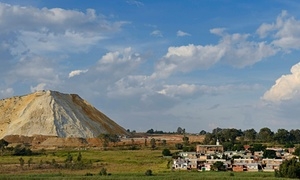
Acid mine water that is expected to flow into the Vaal River from next year must be fully treated by the end of 2014 to prevent water shortages – but the building of treatment plants is yet to start.
Director of water quality at the Department of Water Affairs Marius Keet said yesterday that he believed there was enough time to deal with the problem and that pumps for the treatment plant had been bought.
A document presented to the Department of Water Affairs last month, and leaked to the media, expressed concern that sulphates in acid mine water would cause so much pollution in the Vaal area that water shortages at mines could be expected by 2015.
According to the document, the cost of fully treating the water could exceed R3-billion.
Minister of Water Affairs Edna Molewa yesterday reiterated her department’s commitment to dealing with acid mine drainage, saying she felt it was appropriate on World Water Day to go to the Witwatersrand “to show you the effects that decades of reckless and poorly regulated mining activities have had on our precious water resources”.
“Even though the current government inherited the problem, we are intensifying our efforts and making noteworthy progress” she said.
The department lacked almost R500-million of the money needed to build the three pump stations that would partially treat acid mine drainage in the Witwatersrand’s western, eastern and central basins.
Molewa yesterday visited the Rand Uranium Treatment Plant in Randfontein, on the West Rand, where acid mine water, heavily polluted with heavy metals and sulphates, has been decanting out of the ground since 2002.
She was “pleased that the plant had been upgraded to treat 35million litres of acid water a day, up from 12million litres daily”.
Acidity and heavy metals, including iron, manganese and uranium, are removed from the water at the treatment plants. The water is then pumped into streams that flow into the Crocodile River.
As much as 60million litres of water flow from the mines in Randfontein each day, leaving about 25million litres untreated.
Sulphates are not taken out of the water yet but plans to do so are being investigated.
Though drinking water should contain only 600mg of sulphates per litre, 2500mg of sulphates per litre remain in the water.
Keet said that though the sulphate-rich water would not kill humans, it was not good for them or for irrigation.


